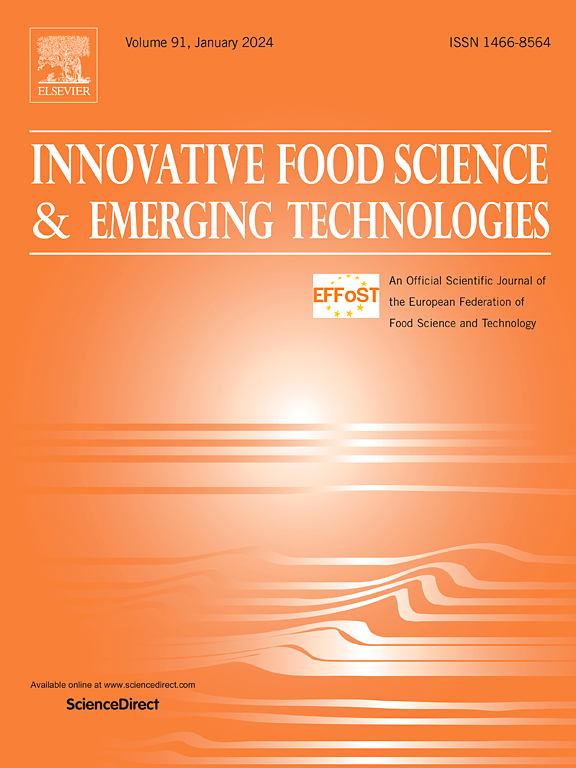探索利用亚临界水改性蘑菇副产品生产壳聚糖及回收有价化合物的环保策略
IF 6.3
1区 农林科学
Q1 FOOD SCIENCE & TECHNOLOGY
Innovative Food Science & Emerging Technologies
Pub Date : 2025-01-06
DOI:10.1016/j.ifset.2025.103923
引用次数: 0
摘要
壳聚糖是甲壳素的去乙酰化衍生物,是自然界中含量第二丰富的多糖。由于其独特的性能和高通用性,它是一种具有巨大潜力的环保聚合物,在各个行业都有显著的贡献。通常,壳聚糖是通过化学或生物方法从几种主要来自海洋的生物质中回收的。亚临界水(SCW)萃取是一种很有前途的可持续创新技术,可以解决传统方法的主要缺点。在不同温度(120°C、150°C和180°C)和苹果酸浓度(0%、5%和10%)的条件下,研究了用SCW从蘑菇(Pleurotus ostreatus)副产品中提取壳聚糖的工艺。在温度120°C、苹果酸用量为10% (w/v)的条件下,壳聚糖收率最高(6.26%±0.09%),是常规方法的4.8倍。SCW改变了聚合物的结构,这可能影响了其功能。几丁质部分去乙酰化,乙酰化程度降低20%,结晶度指数下降。此外,由于SCW促进了水解机制,在液体残留物中实现了显著的有价值化合物的同时回收。本文章由计算机程序翻译,如有差异,请以英文原文为准。
Exploring an eco-friendlier strategy for chitosan production and valuable compounds recovery from mushroom by-products with modified subcritical water
Chitosan is the deacetylated derivative of chitin, the second most abundant polysaccharide in nature. It is a promising eco-friendly polymer with immense potential owing to its unique properties and high versatility, offering notable contributions to various industries. Conventionally, chitosan is recovered from several biomasses, primarily from marine sources, using chemical or biological methods.
Subcritical water (SCW) extraction is a promising sustainable and innovative technology that can address the main drawbacks of conventional methods. This study explores the use of SCW to extract chitosan from mushroom (Pleurotus ostreatus) by-products, considering different temperatures (120 °C, 150 °C and 180 °C) and malic acid concentrations (0 %, 5 % and 10 %). The highest chitosan yield (6.26 % ± 0.09 %) was achieved with SCW at 120 °C and 10 % (w/v) of malic acid, which is 4.8 times higher than that of conventional methods. SCW modified the polymer's structure, which may have influenced its functionality. A partial deacetylation of chitin, as indicated by a 20 % decrease in acetylation degree, and a decrease in the crystallinity index were highlighted. In addition, the remarkable simultaneous recovery of valuable compounds in liquid residues was achieved, attributed to the hydrolysis mechanisms facilitated by SCW.
求助全文
通过发布文献求助,成功后即可免费获取论文全文。
去求助
来源期刊
CiteScore
12.00
自引率
6.10%
发文量
259
审稿时长
25 days
期刊介绍:
Innovative Food Science and Emerging Technologies (IFSET) aims to provide the highest quality original contributions and few, mainly upon invitation, reviews on and highly innovative developments in food science and emerging food process technologies. The significance of the results either for the science community or for industrial R&D groups must be specified. Papers submitted must be of highest scientific quality and only those advancing current scientific knowledge and understanding or with technical relevance will be considered.

 求助内容:
求助内容: 应助结果提醒方式:
应助结果提醒方式:


